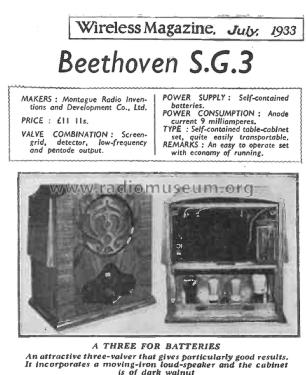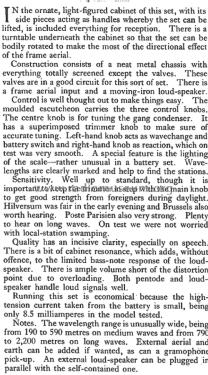- Pays
- Royaume Uni
- Fabricant / Marque
- Beethoven (Brand), Montague Radio Inventions, Beethoven Radio, Beethoven Electric Equipment; London, Manchester
- Année
- 1933 ?
- Catégorie
- Radio - ou tuner d'après la guerre 1939-45
- Radiomuseum.org ID
- 189531
- No. de tubes
- 3
- Principe général
- Récepteur TRF - par réaction (régénératif); Tube à grille écran 1926-1935.
- Gammes d'ondes
- PO et GO
- Tension / type courant
- Piles (rechargeables ou/et sèches)
- Haut-parleur
- HP mais de technologie inconnue
- Matière
- Boitier en bois
- De Radiomuseum.org
- Modèle: Beethoven 53 SG3MC - Beethoven Brand, Montague
- Forme
- Modèle de table vertical décoré (pierre tombale)
- Remarques
-
Beethoven S.G.3
In the ornate, light-figured cabinet of this set, with its side pieces acting as handles whereby the set can be lifted, is included everything for reception. There is a turntable underneath the cabinet so that the set can be bodily rotated to make the most of the directional effect of the frame aerial.
Construction consists of a neat metal chassis with everything totally screened except the valves. These valves are in a good circuit for this sort of set. There is a frame aerial input and a moving-iron loudspeaker.
Control is well thought out to make things easy. The moulded escutcheon carries the three control knobs. The centre knob is for tuning the gang condenser. It has a superimposed trimmer knob to make sure of accurate tuning. The left-hand knob acts as wavechange and battery switch and the right-hand knob as reaction, which on test was very smooth. A special feature is the lighting of the scale rather unusual battery sets. Wavelengths are clearly marked and help to find the stations.
Sensitivity. Well up to standard, though it is important to keep the trimmer in step with the main knob to get good strength from foreigners during daylight. Hilversum was fair in the early evening and Brussels also worth hearing. Poste Parisien also very strong. Plenty to hear on long waves. On test we were not worried with local station swamping. Quality has an incisive clarity, especially on speech. There is a bit of cabinet resonance, which adds, without offense, to the limited bass note response of the loudspeaker. There is ample volume short of the distortion point due to overloading. Both pentode and loudspeaker handle loud signals well. Running this set is economical because the high tension current taken from the battery is small, being only 8.5 milliamperes in the model tested.Notes. The wavelength range is unusually wide, being from 190 to 590 metres on medium waves and from 790 to 2,200 metres on long waves. External aerial and earth can be added if wanted, as can a gramophone pick-up. An external loudspeaker can be plugged in parallel with the self-contained one.
- Prix de mise sur le marché
- 11.55 GB £
- Littérature
- -- Original prospect or advert (Wireless Magazine Jul 1933, Page 615)
- Auteur
- Modèle crée par Roy Johnson. Voir les propositions de modification pour les contributeurs supplémentaires.
- D'autres Modèles
-
Vous pourrez trouver sous ce lien 46 modèles d'appareils, 24 avec des images et 26 avec des schémas.
Tous les appareils de Beethoven (Brand), Montague Radio Inventions, Beethoven Radio, Beethoven Electric Equipment; London, Manchester

